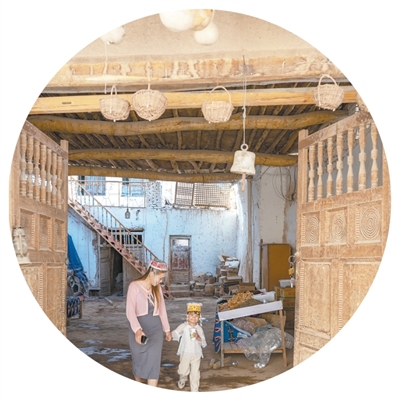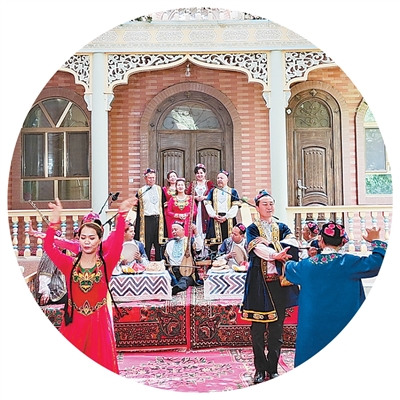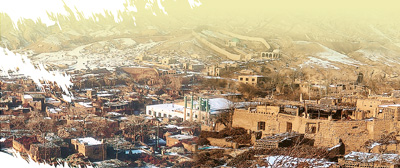




- BRNN
- BRI News
- BRNN News
- Database
Official Documents Polices and Regulations
Inter-government Documents International Cooperation BRI Countries
Business Guide Economic Data BRI Data
Trade
Investment Projects Latest projects
Cases - Content Pool
Shanshan county in Turpan city, northwest China's Xinjiang Uygur Autonomous Region, is home to eight officially recognized traditional villages in China. In recent years, the county has integrated its tourism resources and developed cultural and historical experience zones centered on these villages, turning them into tourist attractions. As a result, Shanshan has seen rapid growth in both its cultural and tourism industries, along with a sharp rise in tourist visits and tourism revenue.
Situated east of downtown Turpan, Tuyugou village is one of Shanshan county's officially recognized traditional villages, known for its well-preserved earthen architecture.

Photo shows the gate of an earthen house in Tuyugou village, Shanshan county, Turpan city, northwest China's Xinjiang Uygur Autonomous Region. (Photo/Zhang Weiguo)
According to Ji Xiang, head of the urban-rural development service center under the county's housing and urban-rural development bureau, the houses are built using clay or simply processed earth materials and are arranged along the slopes of the mountain and the curves of the river. The village's alleys crisscross in all directions, with each home connected to others while still maintaining its own private space.
"There are 73 courtyards and 84 houses that can be used—those in good condition have already been opened to visitors, while the more fragile ones are awaiting restoration," said Ji.
According to Yin Zhixin, director of the housing and urban-rural development bureau of Shanshan county, the county's eight traditional villages are home to a total of 952 well-preserved earthen houses. With walls 40 to 50 centimeters thick, these structures offer natural insulation, staying warm in winter and cool in summer.
Lukqun town was once the economic and cultural hub of the Turpan Basin. Today, it is home to seven traditional villages, including Sangeqiao village. After breakfast, local villager Shata'er Simayi heads to a traditional crafts experience center about a kilometer away to prepare for the day's mulberry bark paper making experience sessions for tourists. Mulberry bark paper once largely disappeared from daily life. But with the rise of tourism, this ancient craft has been revived and is now a popular hands-on experience for visitors.

Actors and actresses perform at the Muqam heritage center in Lukqun town, Shanshan county, Turpan city, northwest China's Xinjiang Uygur Autonomous Region. (Photo courtesy of the publicity department of the CPC Shanshan county committee)
Shata'er Simayi said that a single sheet of A3-sized mulberry bark paper sells for around 30 yuan (about $4.18). At the experience center, some tourists purchased several thousand yuan worth of paper. Thanks to its growing popularity, mulberry bark paper making has become a source of income for local villagers. Once impoverished, Shata'er Simayi has left poverty behind through this traditional craft.
The Uygur mulberry bark paper making craft was listed as a national intangible cultural heritage in 2006.
At the Muqam heritage center in Lukqun town, Ili Muhmet, head of the center, joins other performers as they prepare to take the stage for a Muqam performance. The Xinjiang Uygur Muqam Arts of China is recognized by UNESCO as a "Masterpiece of the Oral and Intangible Heritage of Humanity" and listed as a national intangible cultural heritage in China.
Turpan Muqam, a genre of the Xinjiang Uygur Muqam, features lively, upbeat rhythms and rich, diverse content. Its lyrics are often inspired by folk songs and poetry, embodying generations of life experiences and artistic expression.

Photo shows Tuyugou village at the foot of the Flaming Mountains in Shanshan county, Turpan city, northwest China's Xinjiang Uygur Autonomous Region. (People's Daily/Li Yanan)
"Embracing innovation while inheriting Turpan Muqam is what keeps the art form alive," said Ili Muhmet. By combining classic tunes with fresh interpretations, the art of Turpan Muqam has been revitalized with new energy.
"We currently have over 40 inheritors at different levels, and performances take place once or twice a week," Ili Muhmet said.
Ahmet Yiming, director of the culture and tourism bureau of Shanshan county, said in 2024, Shanshan county welcomed 13.01 million tourist visits, a 24.6 percent increase from the previous year. The total tourist spending reached 6.8 billion yuan, a 28.47 percent rise year on year.

Tel:86-10-65363107, 86-10-65368220, 86-10-65363106